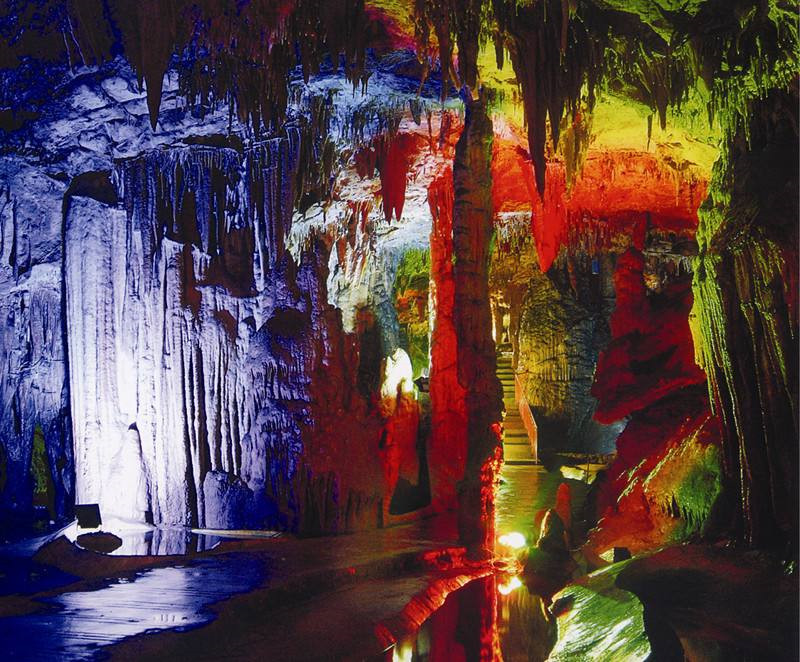
Caiyundong Cave in Zhanyi District, Qujing
Caiyundong Cave (彩云洞) near Huashan Lake (花山湖) is another popular tourist destination at the source of the Zhu River (珠江). The cave stretches approximately 4 kilometers, with 8 main halls identified, 5 of which have been developed for tourism, allowing for a 1200-meter tour. The cave is named for its colorful stalactites, which resemble clouds in the sky. With its ancient formation and unique landscape, Caiyundong Cave is considered a gem among cave attractions.
Origin of the Name
The cave is located at the foothills of Xiandu Mountain (仙都山) and outside Yuxu Palace (玉虚宫), commonly referred to as Changmen Cave (阊门洞) and Tianmen Cave (天门洞). The entrance faces east, and every morning, colorful clouds often swirl around, hence the name Caiyundong (彩云洞).
Travel Guide
Local people from Zhanyi County (沾益县) describe Caiyundong Cave with the phrase: “Crystal flows like waterfalls, jade stones pile into mountains, rocks form ice, and emeralds string like curtains.” Although Caiyundong Cave may not be well-known among the many karst caves in Yunnan (云南), it is a deep, unique, and colorful underground cavern that has recently started to reveal its brilliance as it becomes developed for tourism. Recently, Zhanyi County has promoted Caiyundong Cave as an important new attraction ahead of the Fourth Zhu River Source Tourism Festival (珠江源旅游节).
Caiyundong Cave is a natural dark cave located at the southern end of Huashan Lake, approximately 30 kilometers south of the county seat and 20 kilometers north of the source of the Zhu River. The cave is about 3 kilometers long, spacious, and contains various side chambers. The general width and height range from 20 to 30 meters, with stalactites naturally dividing it into six distinct scenic areas:
- First Hall: Spacious, featuring stone curtains and waterfalls.
- Second Hall: Multi-layered, resembling a towering bamboo forest and dragon pillars.
- Third Hall: Dominated by stone flowers and stalactites, offering a multitude of sights with every step.
- Fourth Hall: Narrow and eerie.
- Fifth Hall: Known as the Serpent Cave (盘蛇洞), filled with formations resembling intertwined snakes, some even bearing scales, suspected to be snake fossils.
- Sixth Hall: Dense with stalactites, though still under development.

Unique Features
The rocks within Caiyundong Cave display a multitude of colors, including red, white, yellow, black, and purple, creating a breathtaking spectrum. One spacious hall’s ceiling is adorned with large and small dark stalactites, interspersed with white minerals. When viewed from the water pool below, the ceiling’s reflection resembles a steep mountain covered in dark vegetation, with patches of mottled white snow, forming a stunning “sea of forests and snowy plains” spectacle. The craftsmanship of nature here is truly awe-inspiring. Cross-sections of many stalactites reveal that colors like red, yellow, and black cover the outer layers, while the inner layers are pure white and beautifully crystalline.
Caiyundong Cave features many white rock formations, and according to guides, the sparkling material found here is highly prized crystal. While there are valuable stones and minerals within the cave, their distribution is sparse and low in quantity, limiting their mining value. Nevertheless, the saying “Crystal flows like waterfalls, jade stones pile into mountains, rocks form ice, and emeralds string like curtains” holds true.
The cave is filled with a variety of stalagmites, columns, and hanging stones. What makes it even more remarkable are the “animals,” “plants,” and even “people” crafted from the formations found throughout the cave. Creatures such as lions, monkeys, peacocks, crocodiles, elephants, and qilins (麒麟) can be seen, along with vivid representations of items like Dali milk fans (大理乳扇) and Xuanwei ham (宣威火腿), making for a breathtaking exploration.
Even more rare is the cave’s vibrant ecosystem. Many rocks and stalactite tips bear tiny, transparent stone buds that resemble newborns, delicate and pure, which slowly grow year after year—this is relatively uncommon in Yunnan’s caves.
How to Get There
Caiyundong Cave is located at the southern end of Huashan Lake in Zhanyi District, Qujing. The nearest major city is Qujing, which can be reached via bus or car. From Qujing, take Highway G320 towards Zhanyi County. Follow the signs for Huashan Lake; the cave entrance is approximately 30 kilometers from the county seat.
Travel Tips
- Best Time to Visit: The ideal time to explore Caiyundong Cave is during the dry season (October to April) when the cave is less humid and more accessible.
- What to Bring: Wear comfortable shoes and bring a flashlight, as some areas may be dimly lit. A light jacket is recommended, as the cave can be cool.
- Guided Tours: Consider joining a guided tour for a more informative experience, as guides can point out unique formations and share stories about the cave.
- Safety Precautions: Follow safety instructions and stay on marked paths to avoid accidents in the cave.


Location:















